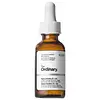What's inside
What's inside
 Key Ingredients
Key Ingredients

 Benefits
Benefits

 Ingredients Side-by-side
Ingredients Side-by-side

Water
Skin ConditioningNiacinamide
SmoothingGlycerin
HumectantDimethyl Isosorbide
SolventAlpha-Glucan Oligosaccharide
CleansingCentella Asiatica Leaf Extract
Skin ConditioningGlycyrrhiza Glabra Root Extract
BleachingPunica Granatum Extract
AstringentLycium Barbarum Fruit Extract
AstringentLactobacillus
Skin ConditioningPolymnia Sonchifolia Root Juice
Skin ConditioningBisabolol
MaskingSilver
Cosmetic ColorantSodium Hyaluronate Crosspolymer-3
HumectantLysophosphatidic Acid
Skin ConditioningLysolecithin
EmulsifyingLecithin
EmollientLaminaria Digitata Extract
Skin ProtectingDisodium Adenosine Triphosphate
Skin ConditioningPichia/Resveratrol Ferment Extract
Skin ConditioningSodium Hyaluronate
HumectantRibose
HumectantUbiquinone
AntioxidantChlorella Vulgaris Extract
Skin ConditioningSaccharide Isomerate
HumectantCamellia Oleifera Leaf Extract
AstringentAstaxanthin
Skin ConditioningErgothioneine
AntioxidantGlutathione
Tocopheryl Acetate
AntioxidantSea Water
HumectantCaprylic/Capric Triglyceride
MaskingMaltodextrin
AbsorbentEthylhexylglycerin
Skin ConditioningXanthan Gum
EmulsifyingCitric Acid
BufferingPolysorbate 20
EmulsifyingO-Cymen-5-Ol
AntimicrobialSodium Gluconate
Skin ConditioningSodium Hydroxide
BufferingPhenoxyethanol
PreservativeWater, Niacinamide, Glycerin, Dimethyl Isosorbide, Alpha-Glucan Oligosaccharide, Centella Asiatica Leaf Extract, Glycyrrhiza Glabra Root Extract, Punica Granatum Extract, Lycium Barbarum Fruit Extract, Lactobacillus, Polymnia Sonchifolia Root Juice, Bisabolol, Silver, Sodium Hyaluronate Crosspolymer-3, Lysophosphatidic Acid, Lysolecithin, Lecithin, Laminaria Digitata Extract, Disodium Adenosine Triphosphate, Pichia/Resveratrol Ferment Extract, Sodium Hyaluronate, Ribose, Ubiquinone, Chlorella Vulgaris Extract, Saccharide Isomerate, Camellia Oleifera Leaf Extract, Astaxanthin, Ergothioneine, Glutathione, Tocopheryl Acetate, Sea Water, Caprylic/Capric Triglyceride, Maltodextrin, Ethylhexylglycerin, Xanthan Gum, Citric Acid, Polysorbate 20, O-Cymen-5-Ol, Sodium Gluconate, Sodium Hydroxide, Phenoxyethanol
 Reviews
Reviews

Ingredients Explained
These ingredients are found in both products.
Ingredients higher up in an ingredient list are typically present in a larger amount.
Phenoxyethanol is a preservative that has germicide, antimicrobial, and aromatic properties. Studies show that phenoxyethanol can prevent microbial growth. By itself, it has a scent that is similar to that of a rose.
It's often used in formulations along with Caprylyl Glycol to preserve the shelf life of products.
Water. It's the most common cosmetic ingredient of all. You'll usually see it at the top of ingredient lists, meaning that it makes up the largest part of the product.
So why is it so popular? Water most often acts as a solvent - this means that it helps dissolve other ingredients into the formulation.
You'll also recognize water as that liquid we all need to stay alive. If you see this, drink a glass of water. Stay hydrated!
Learn more about Water